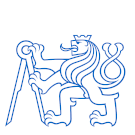155RESE Remote Sensing: Porovnání verzí
m řazení cvik značka: editace z Vizuálního editoru |
|||
| (Není zobrazeno 31 mezilehlých verzí od 4 dalších uživatelů.) | |||
| Řádek 1: | Řádek 1: | ||
==Basic Information== | ==Basic Information== | ||
* | * Up-to-date and complete information are '''ON THIS PAGE''' | ||
* | * Code: 155RESE | ||
* 6 | * Lectures: '''{{Lidé|prof. Dr. Ing. Karel Pavelka}}''' | ||
* finished with an exam | * Practical classes: {{Lidé|Ing. Tomáš Bouček}} | ||
* lectures per week: 2 hours | |||
* exercises per week: 2 hours | |||
* Credits: 6 | |||
* finished with: an exam | |||
* winter semester | * winter semester | ||
==Anotation== | ==Anotation== | ||
The lectures focuse on an explanation of the physical principle on which remote sensing (RS) is based, a technical explanation of measurement methods, the behaviour of individual substances in response to interaction with different types of electromagnetic radiation, and the possibility of using RS for a range of applications. | |||
The lectures contain: introduction to RS. Basic physical and mathematical relations. Image creation. Detectors and sensors. Spectral properties of substances and land features, spectral signatures. Image manipulation, histogram. Image enhancement, edge filters. Supervised and unsupervised classification, clusters, training sets. Practical use of RS. Examples of data. | |||
Generaly, this course shows basics processing methods and use of remotely sensed data. Theoretical lectures provide basics in optics, mathematics, surveying and physics for full understanding of the theme. In practical lessons the theory turns to practice and students process their own data from Sentinel 2 satelite using an open source ESA SNAP software. | |||
;Literature | ;Literature | ||
Lillesand, T.M., Kiefer, R.W., Chipman, J.W.: Remote Sensing and Image Interpretation, 7th Ed., Wiley, 2007. ISBN: 978-1-118-34328-9 | |||
Canty, M.J.: Image Analysis, Clasification and Change Detection in Remote Sensing. CRC Taylot& Francis. 2007. ISBN: 0-8493-7251-8 | |||
==Lectures== | ==Lectures== | ||
''' | '''Lecturer:''' prof. Dr. Ing. Karel Pavelka (pavelka -et- fsv.cvut.cz) | ||
'''Practical | lecturer information | ||
'''short [https://usermap.cvut.cz/profile/571e4f47-beef-4103-9e97-ba9daccc3d1d?lang=en prof.Dr.Ing.Karel Pavelka]''' | |||
'''detailed [https://geo.fsv.cvut.cz/gwiki/Prof._Dr._Ing._Karel_Pavelka/en/ prof.Dr.Ing.Karel Pavelka]''' | |||
Lectures and exercises | |||
* Up-to-date and complete information, see here - '''[https://lfgm.fsv.cvut.cz/vyuka.html remote sensing lectures and exercises]''' | |||
'''Practical exercises:''' Ing. Eva Matoušková, Ph.D. (eva.matouskova -et- fsv.cvut.cz) Ing. Tomáš Bouček (tomas.boucek -et- fsv.cvut.cz) | |||
==Exercises== | ==Exercises== | ||
* Introduction to remote sensing, data downloading | |||
* Data upload to SNAP, subset creation, colour synthesis, spectral curves | |||
* Vegetation (spectral) indices, creation of NDVI map, detection of water areas using spectral indices | |||
* Image filtering | |||
* Unsupervised classification | |||
* Supervised classification | |||
* Segmentation and object classification | |||
* Example of VHR data, pansharpening | |||
* Thermal analysis from Landsat data | |||
* Demonstration of work in Google Earth Engine, detection of burn sites | |||
* Radar data processing, DMT creation | |||
== Academic year 2024/2025 == | |||
Exercises take place every Wednesday from 10:00 to 11:50 in classroom B-973 | |||
Aktuální verze z 17. 9. 2024, 20:21
Basic Information
- Up-to-date and complete information are ON THIS PAGE
- Code: 155RESE
- Lectures:
- Practical classes:
- lectures per week: 2 hours
- exercises per week: 2 hours
- Credits: 6
- finished with: an exam
- winter semester
Anotation
The lectures focuse on an explanation of the physical principle on which remote sensing (RS) is based, a technical explanation of measurement methods, the behaviour of individual substances in response to interaction with different types of electromagnetic radiation, and the possibility of using RS for a range of applications. The lectures contain: introduction to RS. Basic physical and mathematical relations. Image creation. Detectors and sensors. Spectral properties of substances and land features, spectral signatures. Image manipulation, histogram. Image enhancement, edge filters. Supervised and unsupervised classification, clusters, training sets. Practical use of RS. Examples of data.
Generaly, this course shows basics processing methods and use of remotely sensed data. Theoretical lectures provide basics in optics, mathematics, surveying and physics for full understanding of the theme. In practical lessons the theory turns to practice and students process their own data from Sentinel 2 satelite using an open source ESA SNAP software.
- Literature
Lillesand, T.M., Kiefer, R.W., Chipman, J.W.: Remote Sensing and Image Interpretation, 7th Ed., Wiley, 2007. ISBN: 978-1-118-34328-9
Canty, M.J.: Image Analysis, Clasification and Change Detection in Remote Sensing. CRC Taylot& Francis. 2007. ISBN: 0-8493-7251-8
Lectures
Lecturer: prof. Dr. Ing. Karel Pavelka (pavelka -et- fsv.cvut.cz)
lecturer information
short prof.Dr.Ing.Karel Pavelka detailed prof.Dr.Ing.Karel Pavelka
Lectures and exercises
- Up-to-date and complete information, see here - remote sensing lectures and exercises
Practical exercises: Ing. Eva Matoušková, Ph.D. (eva.matouskova -et- fsv.cvut.cz) Ing. Tomáš Bouček (tomas.boucek -et- fsv.cvut.cz)
Exercises
- Introduction to remote sensing, data downloading
- Data upload to SNAP, subset creation, colour synthesis, spectral curves
- Vegetation (spectral) indices, creation of NDVI map, detection of water areas using spectral indices
- Image filtering
- Unsupervised classification
- Supervised classification
- Segmentation and object classification
- Example of VHR data, pansharpening
- Thermal analysis from Landsat data
- Demonstration of work in Google Earth Engine, detection of burn sites
- Radar data processing, DMT creation
Academic year 2024/2025
Exercises take place every Wednesday from 10:00 to 11:50 in classroom B-973
